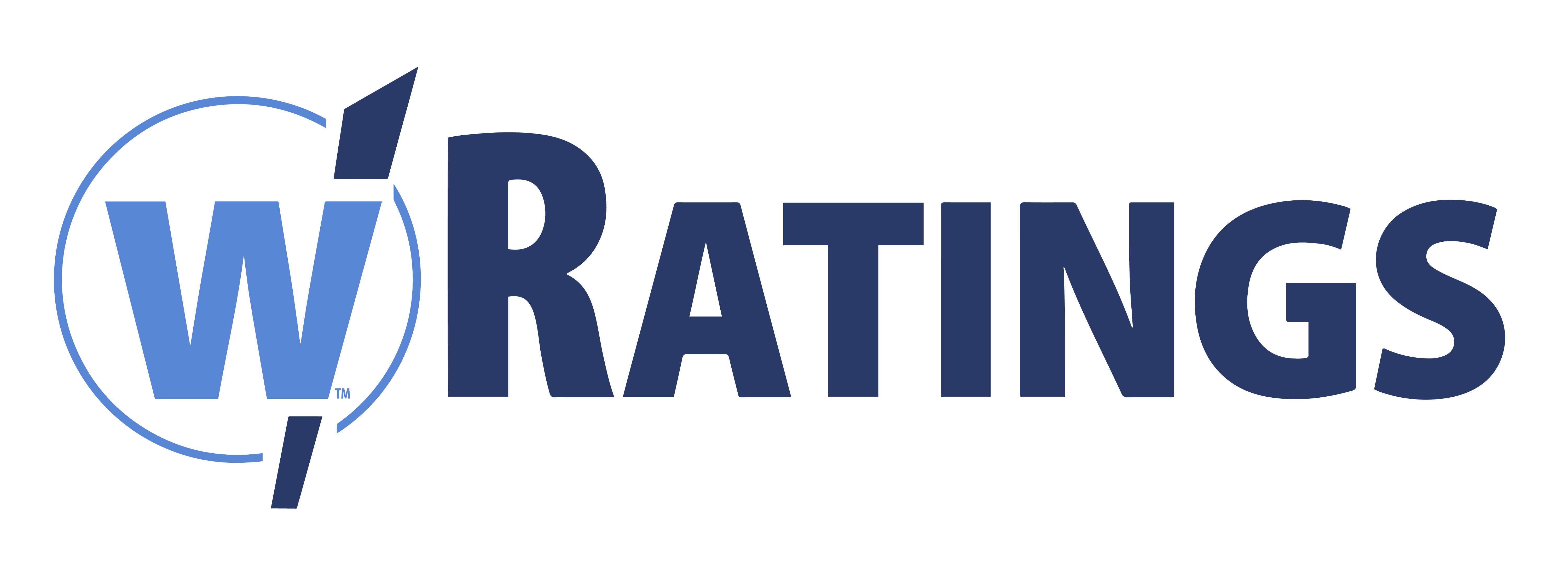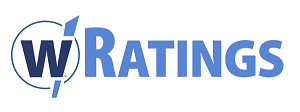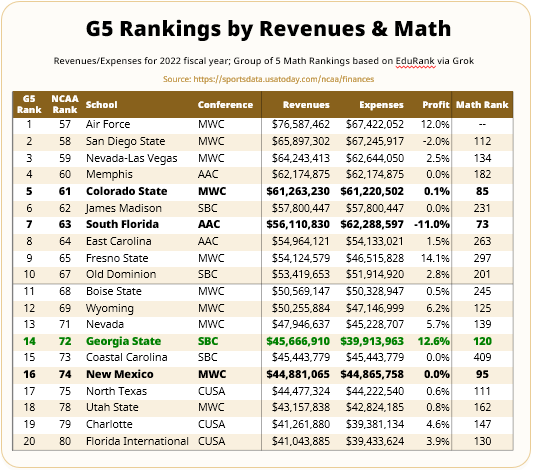NCAA Sports: G5 Upstarts Ready to Outsmart NIL & Revenue-Sharing
Gary A Williams
June 9, 2025
NCAA Sports: G5 Upstarts Ready to Outsmart NIL & Revenue-Sharing
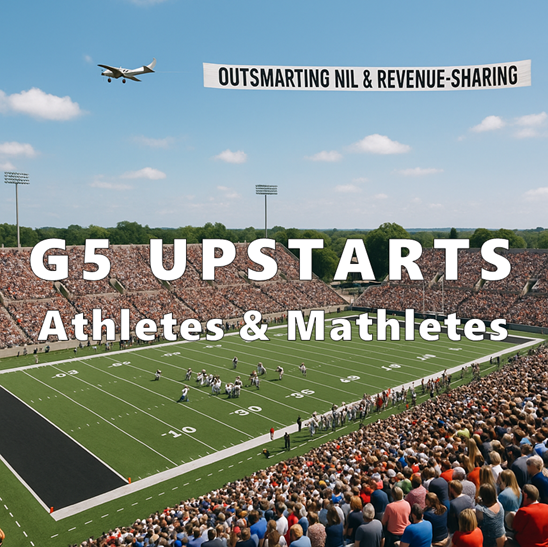
All trademarks are properties of their respective owners.
Six seconds. That’s all it took for Doug Flutie to become the most impactful player in college sports – ever. That’s not hyperbole.
The now infamous game in 1984 pitted Flutie’s Boston College against the University of Miami, and Flutie’s last second “Hail Mary” pass of 48 yards was miraculously caught for the game-winning touchdown. It’s the most successful Boston College marketing campaign to date. Within two years, BC applications shot up 30%.
The official name is called “The Flutie Effect,” based on a 2013 study by Doug Chung from Harvard. By going from “good to great” on the gridiron, college applications increase by 18.7%. To achieve similar success, schools would need to lower tuition 3.8% or pay faculty 5% more to offer a higher quality education.
Ironically, “good to great’ in business was made famous by Jim Collins in his 2001 book. Based on his 15+ years of studying companies that made the move, a key concept was for companies to “confront the brutal facts” by addressing challenges head-on. Management must face reality and make decisions based on data and truth, not denial or wishful thinking.
Large companies possess financial advantages over smaller rivals, just as the Power 4 conference teams can easily outspend their Group of 5 (G5) counterparts. This past weekend’s NCAA Settlement for Revenue-Sharing may help, but some form of NIL (Name, Image, Likeness) contracts will remain.
And “waiting” to see what happens – in sports or business – is not an option. It’s time to confront the brutal facts.
Group of 5 Teams: Confront the Brutal Facts
Many schools are facing a crisis today. US college enrollment has dropped by 15% to 15.4 million students between 2010 and 2021, mostly falling during Covid. By Fall 2024, enrollment was still only 15.3 million students.
No doubt that many University Presidents are considering how to put the Flutie Effect into practice on their campus, and the Group of 5 Teams are in prime position to achieve this. But can a university really increase its enrollment through the Flutie Effect? Absolutely.
First, you have to be seen. College football on TV is a 3+ hour infomercial for the school; College basketball a 2+ hour one. According to Grok (X’s AI tool), an estimated 70%-90% of G5 football games will available on ESPN, ESPN2, ESPNU, ESPN+, CBS Sports Network, or regional channels.
And of course, you need to win. Boise State’s amazing 2007 Fiesta Bowl win over Oklahoma – see it here – is still in effect today. Out-of-state enrollment has increased since then and by 2021, more than half (52%) of students are considered non-resident. Those students pay 3x the tuition of Idaho in-state students. That one game was built into a durable competitive advantage over its rivals.
It’s simple math. Win in sports and kids want to go there. From 1983 to 1986, Georgetown’s basketball success parlayed into 45% more applications. Northwestern won the Big Ten in 2000, and applicants jumped 21%. When Nick Saban took over at Alabama, undergraduate enrollment increased 49% between 2006 to 2020. That was 6 times the national average for colleges.
So how are a few teams from the Group of 5 going to win? They will follow the Oakland A’s formula for winning in the unfair game of baseball: Moneyball. The A’s outsmarted their rivals by confronting the brutal facts about what it takes to win: Don’t buy players, buy runs.
In today’s overbearing focus on paying players via NIL and now Revenue-Sharing, could the timing be any better for an upstart G5 school to benefit from Moneyball? Combining analytics with the transfer portal and savvy high school recruiting, a G5 Moneyball team can be built in a single year.
We pulled the top 20 G5 schools in revenue (2022 latest data available) and dropped in their school’s Math ranking. Assuming the athletes and mathletes team up, three upstart schools appear in the Top 100 for Math programs: Colorado State, USF (South Florida) and New Mexico. But the most potential may rest with Georgia State, which is #120 in Math and sports the second highest profit (12.6%) of the Top 20 G5 programs.
Beyond Meat (BYND) and iRobot (IRBT): Confront the Brutal Facts
Two companies trying to compete against much larger rivals have fallen on difficult times over the last five years. Management’s ability to confront the brutal facts is critical to their ability to survive as an independent company.
The high-flying 2019 IPO for Beyond Meat (BYND) had the stock soaring into the $200s. This year the stock is somewhere between $2.30 and $4.40. Despite being one of the first plant-based meat substitutes, the company lost its way.
So what happened? In a nutshell, they got outcompeted. But to management’s credit today, a rebound with customers is underway. This is reflected in their ability to deliver more customer value which, in turn, has buoyed gross margin growth.
New food categories attract large competitors such as Nestle, Tyson Foods, and Conagra Brands. They can all outspend you. And upstarts like Impossible Foods that partner with fast-food chains like Burger King and Starbucks can also raise both awareness and funding – estimated at $2 billion. Enter Moneyball analytics.
The key part of meeting customer expectations is that customer value has both a numerator and denominator. Value gaps are the spread between what customers expect (importance levels) and a company’s performance (satisfaction levels). Think of it like supply (the company) and demand (the customer).
Today’s top performing companies manage both numbers: expectations and performance.
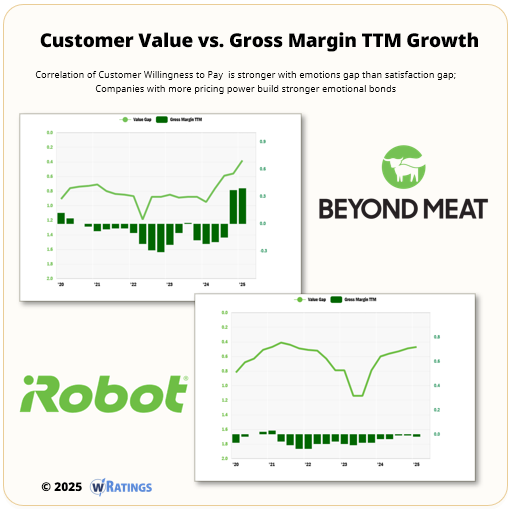
Management confronted the brutal facts about what their customers expected from their products. Customers for Beyond Meat have tethered expectations in the last year or so by about ½ point. The key has been management’s improved messaging and education. They tackled negative perceptions about plant-based meat being overly processed or unhealthy. The “There’s Goodness Here” campaign spotlights ingredient transparency and farming origins. They also partnered with the American Heart Association and dietitians to emphasize health benefits.
iRobot is most well known for its Roomba robot vacuums and Braava mop, but face considerable competition from Dyson, SharkNinja, and many others. Market shared dropped to ~52% in 2023, which is down from about two-thirds in 2018. What happened? They lost their innovation edge, which then impacting their overall value for price.
Management didn’t sit back – they confronted the brutal facts. Following the termination of the Amazon acquisition in January 2024, they reinvested the $97 million termination fee into new products and restructuring. Enter the AutoWash™ Dock. Their new products are focused on customer convenience features, which aligns with consumer desire for hands-free cleaning. The iRobot brand also remains intact with superior reputation, keeping customers loyal.
Confront Your Brutal Facts
Stop waiting. Start confronting the brutal facts of what is happening with you and your competitors. Let the wRatings platform show you the analytics behind what your customers expect and are willing to pay for, and in turn, drive more profitable sales growth.
If you’d like access to our Moneyball analytics and benchmarking database, apply to become a wRatings Insider here.
